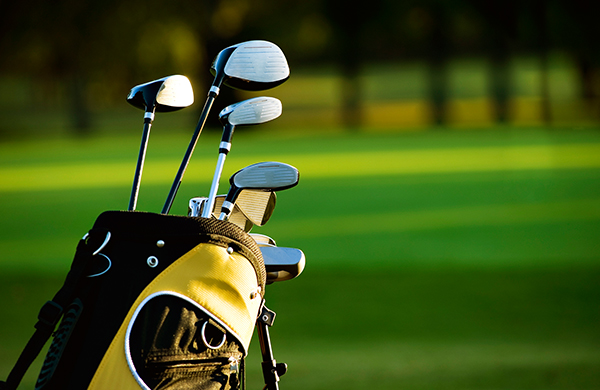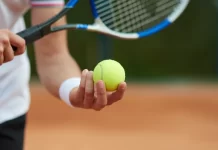When playing a game, rules are to be expected whether to prevent others from cheating or to make the game more fun. But golfing, as a sport, particularly needs rules to make the game safer and to minimize possible damage to golf equipment and courses. Whether you are a beginner or a seasoned player, playing close attention to the rules are a must.
BASICS
FORE!
Probably the most considerate thing you can do during a round is to yell ‘Fore!” A dirnpled projectile traveling at over a hundred miles an hour can really do some damage to muscles, bones, and eyes. If you hear this utterance expelled from someone’s lungs, proper etiquette is to take cover as best you can. Most choose to hit the deck.
COMMUNICATION DEVICES
Avoid bringing beepers, pagers, or cellular phones onto the golf course. If you must do so, turn them off while on the course. Also, if your watch beeps, remember to turn it off at the starter’s desk. Having these things go off whether accidentally or intentionally when a player is swinging is considered very rude. You may find yourself talking on the phone and not be aware that you are within earshot of the person currently playing. Enjoy the course and the scenery; let the office survive without you.
MOVING RIGHT ALONG
As previously stated in the rules, golfers are obligated to keep the game moving. Play without delay. Once all the players have sunk their putts, place the flag in the cup, and move on quickly.
IT WENT THAT’A WAY
Watch your playing partners hit the ball. This way you can help them locate it if need be. This too results in faster play. Also, do not look for your ball or someone else’s ball for more than three minutes.
CLOTHING AT THE CLUB
If you’re going to a club, call ahead to find out what the dress code is. Generally tee-shirts or halters are not allowed on the grounds. If you’re not sure of the dress code, a collared shirt is always appropriate. Some golf clubs don’t allow shorts either, so pants are always appropriate.
NO SHIRT, NO SERVICE
Men, no matter how hot it gets on the course, you should never remove your shirt. Ladies, avoid this too.
OH, YOU KIDS
If small children are accompanying you out on the course, that’s fine. However, make sure that a chaperon accompanies them. Children, being who they are, can interfere with many a golfer’s game.
CHEATING
Cheating is very easy to do during a golf game. One can write down a 5 on the scorecard instead of a 6, or move the ball to improve the lie without recording a penalty stroke. However, there are times when someone cheats without knowing it. With all the rules golf has, it’s no wonder. If you spot someone cheating, whether intentional or not, the best thing to do is take care of it right there. Needless to say, you should handle this with your most diplomatic balm. Politely informing a player of their infraction at the time of its occurrence gives the player an opportunity to correct his or her temporary lapse.
PREGAME
TIMING
Arrive at the course on time. Tee times are tight. Don’t hold up the rest of your two-, three- or foursome. If for some reason a partner is late, notify the starter so he/she can adjust the tee-off times.
IT’S TIME TO CHANGE
At most clubs, locker-room facilities are avail- able. If you need to change any clothing before playing, do it there. Even if you’re only changing shoes, please do it in the locker room, not in the parking lot or on the course.
BAG THE PRO SHOP
If you bring your clubs/golf bag into the pro shop, unforced Jerry Lewis-t7ype errors await you. If you do bring your bag into the shop, the salesperson will make it loud and clear to you to remove the bag from the premises. Park your bag in the area allotted for bags before you venture inside.
UP IN SMOKE
If you need to smoke out on the links, ask your playing partners if it’s okay to light up. Most of the time they’ll say it’s fine with them. It’s simply good form to ask first. Also, remember to keep the course clean. Do not leave cigarette butts on the grounds, and refrain from putting them out on the green.
AT THE TEE
GREETINGS
Be the first to step up and introduce yourself to new playing partners.
WHO GOES FIRST
In friendly play off the first tee, decide amongst yourselves the order of play. If ladies are playing in a mixed group, they should be asked to play first. For more serious play you may draw straws. Some prefer to flip a tee. Proceed by throwing a tee in the air and let it land inside the circle of the players. Whoever the tee is pointing to is out. For instance, if you’re playing with a foursome and the tee is flipped, whoever it points to first becomes the last to tee off; when the tee is flipped again, whoever the tee is pointing to is out again, and they become the third person to tee off, etc. Sometimes after players have teed off they stare and moan at the ball they’ve hit. It is not necessary to wait for them to get out of the box. Have a tee in your hand and step up. It is not rude to do so even if you’re out of order. This action also lets the player know that they’re slowing things up and that they should be aware of their behavior. Remember, the game is not to be rushed, but it is to be played in a timely fashion.
WHICH TEE MARKER IS FOR YOU?
Tee markings allow golfers of different abilities to play together. It is quite common for golfers in the same group to play from different tees. Players should use the tee most suitable to them. If you’re a beginner, tee off from the tee marking that’s closer to the hole. Some of the newer courses have as many as five tee stations, starting with beginner and advancing to expert. A general rule of thumb is that red tees are designated as the ladies tees; the white tees are for the average player; and the blue markings are for advanced or experienced golfers. Men who are beginners should generally tee off from the white tees.
SEEKING AUTOGRAPHS AT A TOURNAMENT
A good time to ask A player for his or her autograph is after the player has had a chance to relax after the round Let him/her wind down and perhaps have a drink. After they’ve done that many return to the practice area. This is a good place to get their signatures.
Refrain from asking a pro for an autograph right after he/she has finished the hole. This is a time where they must focus solely on their games. Any diversion from that focus is not appreciated. Let them proceed to the next tee quickly without shoving a pen in front of them.
Use your good judgment and refrain from asking for an autograph when someone is eating dinner or in the bathroom. The best way to get an autograph is to call or write the PGA or the LPGA. These organizations will send you a list of addresses where you can write to players and ask them for their John Hancocks.
STAND OFF
When a player is teeing off, the others in the group should be standing together out- side of the markers and off to the side to avoid being a distraction. Standing behind a player who’s teeing off is akin to reading over someone’s shoulder. It is rude and should not be done. If you have to ask if you’re in the way, this too is a distraction. Use your common sense.
KEEP IT DOWN
Respect your fellow players. Talking, moving, or even standing close to a player while playing is poor judgment, not to mention potentially dangerous. You should refrain from whispering when a player is at the tee taking his or her practice swings and is ready to hit away. If, inadvertently, you have in some way disturbed the golfer during his or her swing, apologize. If you don’t, the rest of the game will be filled with unnecessary tension.
ON THE FAIRWAY
COOL YOUR JETS
Sometimes we’re anxious to tee on the next hole as soon as we finish the previous one. You might even feel tempted to move along the group ahead of you while they’re taking their second shot out on the fairway. Try to refrain from such behavior. The group ahead of you is most likely doing their best to move along too, so wait until they’re out of ball-striking distance.
THE DIRT ON THE DIRT
Proper play includes taking divots. In fact, if you’re not taking them, you’re probably not swinging very well. If you’ve just sent a chunk of real estate the size of Rhode Island into the next fairway, please pick it up and put it back. Replacing divots is one of the cornerstones of proper golf etiquette. Replacing divots is also essential to maintaining the course. Would you want to play on a course riddled with holes? Of course not. Chances are you wouldn’t want to find a great shot of yours nestling in one either. Riding carts often provide a small shovel and a bucket of sand to assist you in repairing a divot. Please use it. If you happen to see another hole in the earth nearby, it’s a good idea to fix that one too.
CARTING ABOUT
If you’re driving a cart on the course, do not pull up behind the player. Just as when standing at the tee to watch a fellow golfer swing, park alongside the golfer, but far enough away to avoid being a distraction. Riding carts and pull carts should never encounter the green. The “carpet” is usually softer than the fairway and is very susceptible to damage. Pull carts, like shopping carts, can at times have minds of their own. Whether you rent a pull cart or use your own, make sure it’s stable so your bag doesn’t accidentally topple over, spilling your clubs and distracting a player’s swing. Carts also tend to squeak, so check to make sure that an annoying sound is corrected by you or at the pro shop. Make sure your cart is generally in good shape, and that everything is tightened. If not properly maintained, cart wheels have been known to fly off and speed away from the golfer. If this happens, say on the second tee, you’ll be lugging the wheel, the broken cart, and the bag for another seven holes.
Etiquette suggests placing your pull cart or riding cart right alongside where you will build your stance. This way, after you hit the ball, only a step or two is required to move on to your next shot, hence, keeping play moving.
Some golf courses make riding carts adhere to what’s called the 90′ rule. This means that carts must stay on the cart path and that the cart must be pulled up parallel to where the ball is. You cannot take the cart out onto the fairway to the ball. If you are unsure of which golf club to use, simply take more than one club to where your ball is. Having to go back and forth between the cart and the ball slows play tremendously.
If you are allowed unrestricted cart movement on the course, remember to turn off the cart before playing your shot. To that end, if you’re sitting in the cart next to your fellow golfer, keep in mind that releasing the cart brake or throwing your clubs carelessly onto the cart causes a major distraction. Carts should also be parked to allow enough space for other carts to pass. Be aware of your actions.
HOW MANY PRACTICE SWINGS ARE ALLOWED?
Practicing your swing is meant for the driving range, practice green, and lessons. It is not meant to be perfected on the golf course. In fact, except for the tee, taking practice swings when it was your turn to hit was not always allowed by the Rules of Golf. However, no such rule exists today, so technically there are no limits on how many practice swings you’re allowed to take. For the most part, when it’s your turn to hit, one or two should be enough. The longer you stand over your golf ball trying to set up the perfect swing, the tighter your body gets.
Your mind starts to go around in circles and becomes deceptive. This results in slow, tedious play. In fact, when many pros step up to the ball, they do not take practice swings because they’re fined if they slow up the game. Pros are limited to forty five seconds to hit their shot from the time they reach their ball and the group in front of them is out of hitting distance. The key is to practice your swing while others are practicing theirs. When it’s your turn, be ready and hit away, or as the case may be, putt away. If for some reason you find yourself taking more than two practice swings, make up for the time by moving more quickly on the course. If you’re waiting to play because the group ahead of you is still in range, you can take as many practice swings as you like.
WATCH WHAT YOU SAY
It’s okay to point out the makeup of a hole. It’s another thing to say something like “Watch out for the pond on your left, or the hazard on the right.” It is rude to alert a fellow golfer about impending trouble and is never appreciated. If someone offers you unnecessary advice, be tactful and tell them that you appreciate their words, but would prefer not to be helped.
UMBRELLAS
If you’re using an umbrella, remember that it can make a lot of noise when it is opened and closed. Be careful not to do either when a player is about to hit away.
WHEN A TIE OCCURS
If you find yourself in the same position away from the green with another golfer, decide among yourselves who should shoot first. The same goes for being on the green. See the Who Goes First section in the ear- lier part of this chapter if more than one player ties on a hole.
TAKING MULLIGAN
Dropping a new ball after making a poor shot and not taking a penalty stroke is known as a Mulligan shot. Even though the Mulligan is occasionally taken during friendly play, it is illegal according to the Rules of Golf. The truth is Mulligans are a tremendous waste of time and are a major contributor to slow play. Some folks feel they deserve to take Mulligans every time they hit a poor shot, and the average golfer can hit many of them. Buck up and take responsibility for your game and your swing. If you feel the desperate need to hit the ball again, do so and take the stroke. This will soon cure your desire to take a Mulligan.
THE FLYING CLUBS
We can all get frustrated on the course. Our rage can occasionally result in throwing our clubs. This is considered very bad form and you can injure your fellow players. If for some reason you find yourself hurling clubs, throw them forward; that way at least you can pick them up on the way to your ball and not slow the game down.
THE NEXT TEE BOX
As you approach the green by foot or riding cart, find the next tee box. It’s a good idea to place your clubs or cart in that area and then arrive at the green. After everyone has holed out they can go straight to the next tee and tee off without having to go back- ward or sideways to find their carts and clubs, making for faster play.
If your ball isn’t quite on the green, you can do two things: play the shot first then bring your clubs to the tee and return with your putter, or bring your clubs to the next tee and carry back your putter with the club you’ll use to get onto the green. Be careful here: When two clubs are out of the bag, it’s easy to lose one.
PLAYING THROUGH
Playing through is allowing the group of golfers behind you to play ahead of you, and it is the right thing to do. However, if there were any situation in golf where generally civil folks lose it, this is it. Egos tend to clash when a good group of golfers catches up to an average group. The average group tends to feel inferior, while the better group tends to feel superior. Both are wrong. Letting faster players play through is the right thing to do, and those that are playing through should see it as a courtesy, not an entitlement.
Playing through can occur under a variety of circumstances. As stated, some foursomes play faster than others and can encounter a group at the tee with no one on the green in front of them. If twosomes are on the course, more than likely they’re playing faster than foursomes and they would like to play through too. (Twosomes should pair up on the course whenever the opportunity presents itself.) A good place to play through is at the turn after the first nine holes have been played. Par threes, since they are shorter, are also a good place to play through. Under these circumstances the slower group should hit away, walk to the green, mark their balls, and indicate to the next group at the tee to begin.
Once a group is offered the opportunity to play through, they should say thank you and start to play. Any bags, tees, carts, or clubs belonging to the group that is letting the group behind them play through should be removed promptly. The group playing through should not take Mulligans. If a ball is lost, they should not take a long time to look for it.
If a course is particularly crowded and players are waiting to tee off at every hole, playing through will not speed things up, and therefore this courtesy should not be extended.
CRASH GOES THE WINDOW
occasionally things might go badly for you on the course. Say you’ve just sliced your favorite dimpled projectile through a window in a house on the edge of a course. Not only would the rules demand you take a stroke, but it would be poor etiquette for you to swing from the homeowner’s dining room carpet. Technically, when a homeowner purchases a house at a golfing community, they assume the risk. They understand that there’s a chance a ball may dent a shingle, crack a window, or wind up in a soufflee, and they’ll have to pay for the repairs. Homeowners also recognize that they need to install some sort of protective device to stop such things from happening.
However, that’s not always the case. There have been cases where course owners have had to pay for the damage. Etiquette wise, the right thing to do is to back up and come clean to the homeowner and offer to pay for replacement of the window.
ON THE GREEN
BAGS, CARTS, CLUBS
Before stepping on the green, leave your bags and carts outside on the skirt (fringe) of the green. On many occasions you can even take your bag or cart to the next tee and then bring your putter with you back to the green and proceed.
TAKE IT FASY
The green is more fragile than the rest of the course. Please treat it so. Walk softly, never run. Remember to pick up your feet so as not to leave long, dragging cleat marks on the carpet.
REPAIRING BALL MARKS
When a ball lands on a green it often makes a deep indentation known as a ball mark (this is not to be confused with marking your ball). This indentation needs to be repaired by the golfer who hit the ball. This is done with a golf tee or a ball repair tool. Depending on how the ball lands, it is sometimes difficult to spot this mark. Once it is discovered, take the repair tool or the tee and gently dig around the mark and manipulate it until it becomes even with the ground. Then take your putter and tap down on it to make sure it is firmly in place. If you see other ball marks on the green, repair them too, if time permits.
CLUBS
Refrain from letting clubs drop on the green. The “carpet” is very sensitive. Dropping a club on a green can cause unnecessary indentations that will need to be repaired.
TENDING THE PIN
If you’re playing without a caddie, the player with the ball closest to the cup tends the pin. Do not automatically remove the pin from the cup, as some may prefer it left in to help them locate the cup. If the pin is in the cup, remove it once the player putts. Do not wait for the ball to get near the cup. To tend the pin correctly, hold the shaft at arm’s length. If it’s windy, steady the flag. Also be aware of shadows. Make sure that your shadow is on the same side as the pin and the flag. Also make sure it’s not on the putting line. If the player about to putt requests the pin be pulled, do so, remembering not to yank it out but to slowly turn it and pull it out gently. If no players want the flag stick in the cup, lay it down on the fringe or skirt of the green, not on the green itself.
The first person who holes out should be the one to retrieve and replace the flag- stick after the last person sinks his or her ball. This allows the last person putting to move on to the next tee box without having to find the flag, pick it up, and place it back in the cup, which would obviously slow the game down.
THE LINE OF PUTT
Once the ball is on the green, there is an imaginary line that leads from the ball to the cup. Stepping on it is akin to punching the player in the face. Granted, you may at times feel like doing that, but hold off until you’re in a boxing ring.
HOLING OUT
After sinking the ball into the cup, please remove it promptly. Although more than one ball can fit into the cup, it’s bad form to leave it there. Many golfers are a superstitious lot and having more than one ball in a cup can set them off. Please respect them.
After everyone has holed out, place the flag carefully in the cup using two hands. This makes for less wear and tear on the cup, resulting in less maintenance for the course.
SUPPORT CLUB
You may have seen a pro on television after sinking a putt leaning on top of the putter grip for support while removing the ball from the cup. As much as you might like to copy the pros, avoid doing so in this case. Leaning on the putter pushes the carpet down around the tin, causing an unnecessary break and changing how a ball will roll on the green. Breaks on the green should only be created by the course architect or Mother Nature, not the player.
SCORING
Whether the last hole was good or bad, we all tend to be anxious to write down our scores and move on to the next tee. Refrain from placing your score on the card until you arrive there.
BUNKERS
ENTERING AND EXITING
Most bunkers are sand traps, sometimes referred to as “the beach.” Bunkers however are a bit more fragile than the sand on the shore and should be treated as such. The lips and the rims of bunkers can be easily damaged, so enter and exit the sand trap from the low sides. Though you may be tempted, never jump in or climb up the wall of a bunker.
WHERE TO STAND
If your fellow golfer is playing from the bunker onto the green, chances are some of you are already on the green. This is not an opportunity to line up and practice your putt. This is one of the tougher shots of the game, so there’s no need to increase distractions. Stand out of view and let the person in the bunker take his or her shot.
RAKING THE SAND
Locate the rake before you enter the bunker. Once you have hit your sand shot, retrace your steps and pick up the rake outside of the bunker. Retrace your steps once more and rake backward to the fairway. Leaving the bunker in a different direction than you came in makes for more footsteps to be raked over, hence slowing down the game. Always leave the rake outside the bunker.
POST GAME
AFTER THE ROUND
When the round ends, extend a warm hand- shake to your playing partners. This is especially good if you’ve had a poor round. It ends the game on a positive note. Whether your round was good or not so good, if you’ve taken a caddie with you, tip him or her well.
RENTED EQUIPMENT
If you have rented equipment, clean off the clubheads and return the clubs to the pro shop or rental facility. If you have rented a cart, return it to where you picked it up or ask an attendant where it should be returned to.
CLEANING UP
Clean your golf shoes of grass and dirt after you have finished playing. Remove your shoes before entering the clubhouse, bath- room, or any dining facilities. Take a shower once you’ve finished the round. If you’re unable to do so, wash your face and hands. It’ll make you feel good, and if you’re having lunch, you’ll look much more presentable.
FINALLY …
A good Sport who’s had a great round buys lunch.





